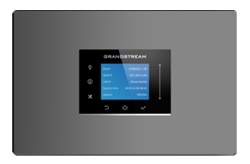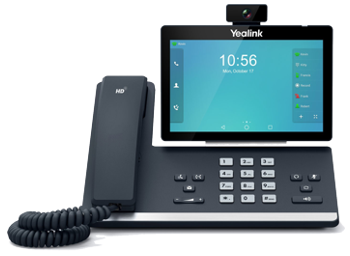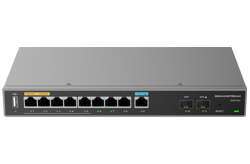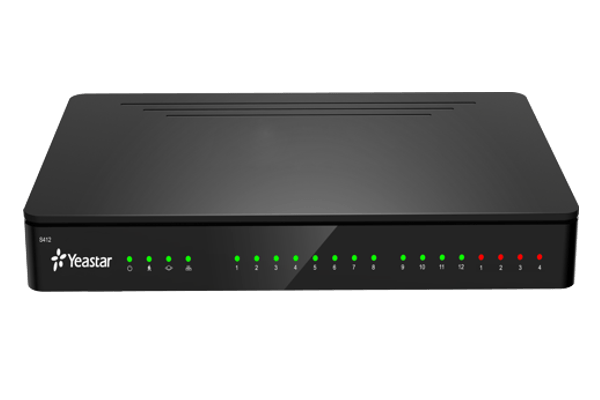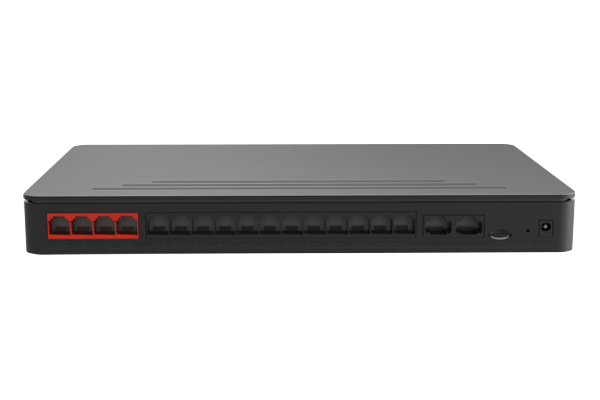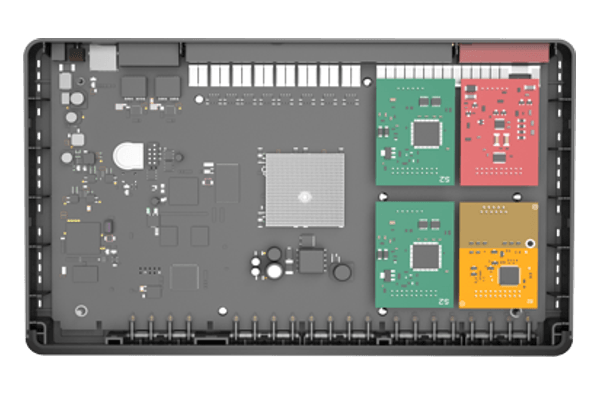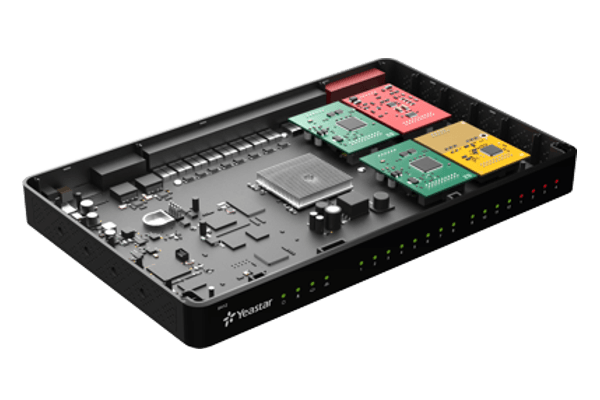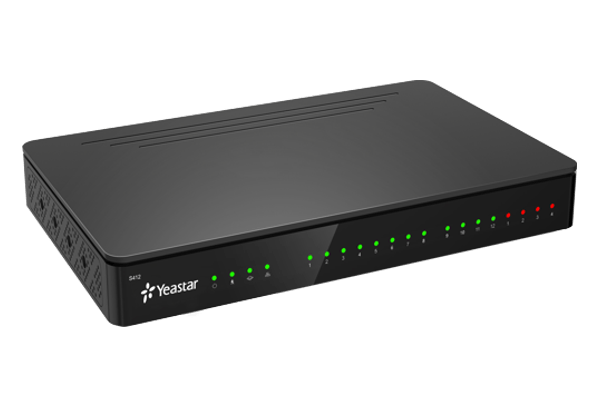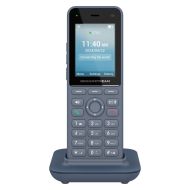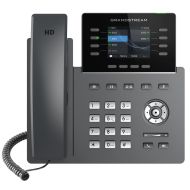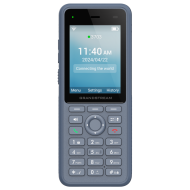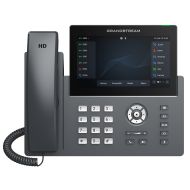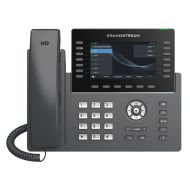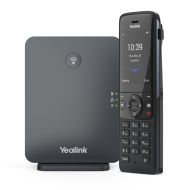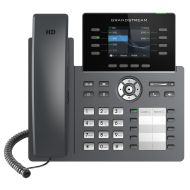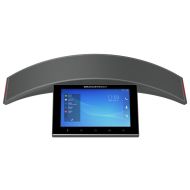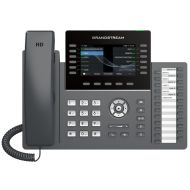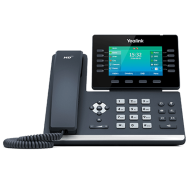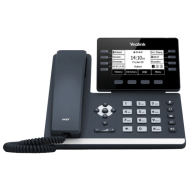YeaStar S412 PBX Phone System VoIP Hybrid
YeaStar S412 Small Business PBX Phone System Brief
This SOHO (Small office / Home Office) and start-up business phone system comes packed with features. It is also a Modular Design - allowing flexible set-up and configuration for most small group users.
This is an VoIP+ analog line telephone basic phone system with robust features for it's start-up or entry level class. Designed specifically around regular analog desk phones and POTS (Plain old telephone line) service needs. This model is specifically for small workgroup business use in offices with 1 to 10 employees, where low call volume occurs. The S412 still offers the same great call group features of other systems with more capacity and higher end VoIP technology.
VoIP PBX calling is standard and this model comes with 8 fixed FXS ports (so you can use "analog telephones" and is customizable with 4 module slots, which allows you a flexible combination of FXS, FXO, BRI and GSM/3G/4G interfaces for telephone services. Additional module mix allows for: 2 module slots for internal FXS extensions (S2 Module only), 2 module slots for FXO/external Analog telephone lines (O2/BRI/GSM/3G/4G Module only).
400+ Phone System Features
This IP-PBX Phone System includes - 400+ Phone System Features which come standard and build-in, including IVR/AutoAttendant, voicemail, email, extension set-up, outbound/inbound routes and more...

Basic features of YeaStar S412 VoIP phone system
If you're keeping older analog desk phones, and not planning to expand into higher end IP or VoIP based systems, the S412 is perfect for you. It is generally used in smaller offices or businesses where using IP technology is a concern or to reduce outlay costs to bare minimum. This model still provides the same great features as other models, with-out larger VoIP capacity. The 4 line, 12 analog extension ports still offer generous POTS line (Plain Old Telephone Service) for hardwired telecommunications.
The module design architecture of this system also allows for adding GSM / 3G / 4G LTE for access issues where even analog telephone lines are a problem. Add calling using mobile network connection and VoIP as an added back-up solution to analog lines or internet service calling through SIP/VoIP trunks.
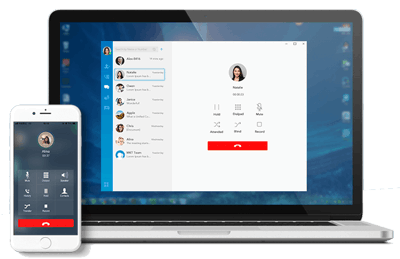 YeaStar S412 Unified Communications
YeaStar S412 Unified Communications
The S412 works with Yeastar Linkus UC softphone and Linkus Cloud Service - experience the ultimate convenience of doing business anywhere, on any device.
Connect - Eliminate complexity and connect on any device anywhere with Linkus UC Softphone.
Communicate - Voice, conferencing, messaging. Get all advanced features for smarter conversations.
Collaborate - Corporate Directory. Presence. File Sharing. It’s about the team-up.
CRM Integration - Salesforce CRM, Microsoft Dynamics 365, Outlook Contacts, Google Contacts.
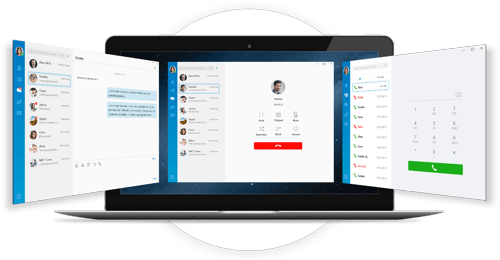 LinkUS Mobile Device App includes: HD VoIP Calls, Presence information, Company directory listing, Instant Messaging, Conferencing, SRTP Secure Media, Advanced call handling.
LinkUS Mobile Device App includes: HD VoIP Calls, Presence information, Company directory listing, Instant Messaging, Conferencing, SRTP Secure Media, Advanced call handling.
Check your voicemails and call in/out of the office main PBX System lines. Available for iOS and Android mobile devices.
LinkUS PC includes the mobile features and a few additional ones, such as: File sharing, CRM integration.
Multiple Third Party IP Phone Device Integration
YeaStar is one of the only manufacturer who fully integrates Automatic Provisioning of third party IP Phones. That's right - they integrate with other popular brand manufacturers' SIP endpoints - right out of the box. Third party device provisioning is available for these IP Phone brands available here at smallbusinessphones.ca: YeaLink, GrandStream, Snom, Panasonic, Mitel, Cisco, Alcatel, Fanvil, and more.
Auto-provisioning is also available for YeaStar Gateways - allowing you to expand your Analog to SIP telephone line capacity with different YeaStar IP-PBX phone system supported models.
VIEW COMPATIBLE IP PHONE MODELS
Maximum call capacity allowed between all telephone lines, VoIP lines & trunks, extensions and callers on the phone system at any time.
SIP (Session Initiated Protocol) is a term used for digital Voice-over-IP end-point devices. SIP extension devices and/or IP phones can include: desktop IP phones, cordless IP phones, mobile devices running specific SIP apps, PC's/computers running SIP applications for telephone calling, integrated video phones, boardroom and conference table phones.
The maximum VoIP (Voice-over-IP) trunk or line capacity you can add to this PBX telephone system.
Maximum analog telephone line port capacity. These are the "physical" line ports shown on the back of the system. Analog interface "port" lines are also known under other term names, such as:
FXO (Foreign Exchange Office), POTS (Plain Old Telephone Service), PSTN (Public Switched Telephone Network), standard line service, local telephony, hard wired lines, fixed lines, and Landline(s).
Analog telephone line service is traditionally provided by your "telephone line company".
Analog FXS (Foreign Exchange Subscriber), RJ11 ports are the physical ports you can use for standard (none-IP based) analog telephone equipment such as fax machines, desk phones, cordless phones and boardroom/conference room phones.
This is traditional telephone technology which is widely being replaced by SIP/VoIP IP based devices.
Connects two or more sites using SIP / VoIP Technology - IE: Networked site to site PBX systems to provide internal company resource sharing.
AutoAdmin or IVR (Interactive Voice Response) is a pre-recorded message your callers get when they call your telephone lines. It provides key instructions to dial departments, other recorded messages or sub-menu AutoAdmins and extensions on your telephone system.
IE: "Thank you for calling XYZ Company - please select from one of the following options, or if you know your party's extension - you can dial it now...etc.".
When you house or have several different companies in the same office
or building, you can have multiple IVR's/AutoAdmins or pre-recorded
settings set-up for each separate company you house.
The PBX allows you to designate different events or have different
answering functions based on each individual company on your phone
system.
You can record calls based on certain criteria, such as: Telephone lines (specific and global), Extensions, Call Centers - all calls in a group or department under a Supervisor, all telephone lines, specific extensions, or globally for both extensions and telephone lines).
Recorded calls are usually stored on a secondary media such as USB / SD Card, or USB powered drive, or NAS drive connected to the main phone system. You can usually review and download the recorded call sound file depending on your system model and brand as each may have different storage or CDR (Call Detail Record) functions available to access recorded files.
CDR = Call Detail Records. With most phone systems today - you can search, filter, report and download call records to further process the data for sales & marketing or security purposes. In some cases, the CDR logs will also integrate with specific third party CRM platforms.
Multi-language support provides options on your system to enable/disable language settings if required. IE: you can have English, French, Spanish, etc. as main system feature settings for all or partial functions on the system for callers and users.
SIP (Session Initiated Protocol) allows for video calling with compatible devices. Some manufacturers integrate video into their IP Phones, which also integrates with the main PBX Phone system for making and receiving video calls through the compatible devices.
In some cases, you can also use third party software or hardware with SIP Video calling.
SIP Video Codecs supported and available on the main PBX System.
Security access protocols supported for internal and external/remote access to the main system box.
In most cases, PBX use a industry standard port for accessing the WebGUI interface. The access port should be changed when setting up your phone system to a different port for additional security.
This feature allows you to set-up and configure SIP Endpoints (compatible IP phones) from the main system.
First you would set-up your extensions / IP desk or cordless phones and extension features in the main system, then push the configuration file to single, multiple or all SIP endpoints at once from the main PBX Phone System.
This eliminates the need to manually configure end-point devices from their individual WebGUI interface, saving a great deal of time and effort.
This also allows you to change single or multiple devices at once later on after full installation is completed, as your needs and feature use changes on the phone system functions.
As with Auto-Configure SIP Endpoints, in some cases you may need to manually adjust phones and features. Most IP-PBX systems still allow you to manually configure and tweak settings on individual extensions and end-points depending on your needs.
Although faxing has become a less used business function, IP-PBX Phone Systems on the market today still allow for faxing capabilities built in.
In most systems you can set-up to capture faxes and send them to email - saving ink and toner. Additionally you can eliminate the cost of having a separate fax telephone line and just use existing voice lines to handle faxes. Most phone systems can identify a fax call coming and route it to an analog extension (fax machine plugged into the phone system as an extension), or you can have faxes sent to email (In PDF format) for administration review and handling.
Fax functions generally also allow you to send out faxes from the main system as PDF/document uploads to the system. Or, individual users can login to access their own faxing functions and send out faxes from their extension features.

